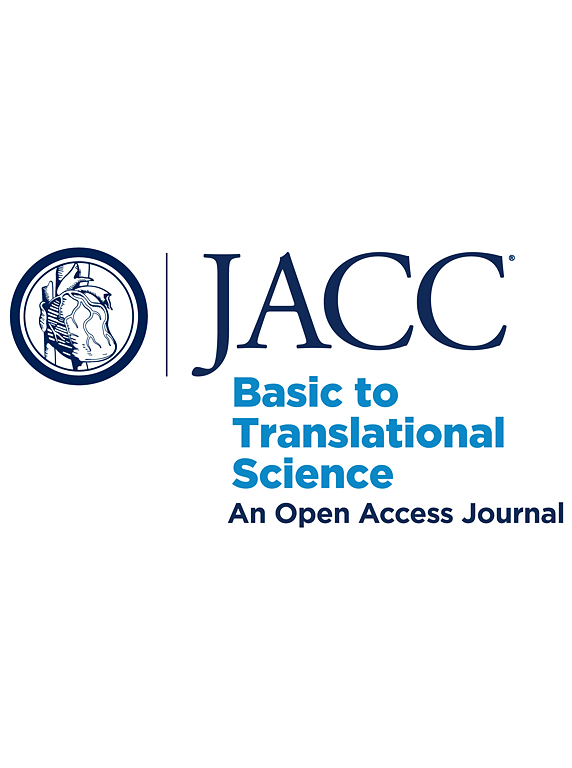Controlled Right Ventricular Pressure Overload Can Rescue Left Ventricular Dysfunction by Promoting Biventricular Adaptive Hypertrophy
IF 8.4
1区 医学
Q1 CARDIAC & CARDIOVASCULAR SYSTEMS
引用次数: 0
Abstract
Pulmonary artery banding (PAB) has been investigated as a therapy for left ventricular (LV) dysfunction in pediatric dilated cardiomyopathy; however, the underlying mechanisms of action of PAB-induced LV rehabilitation remain unknown. This study aims to establish a small animal model of PAB-treated LV dysfunction to document the biventricular hemodynamic and tissue-level modifications promoted by PAB. Sprague-Dawley rats underwent left anterior descending (LAD) artery ligation (LV dysfunction model) followed by PAB 1-week post-injury (LAD + PAB, n = 13). Controls consisted of sham (n = 16), PAB-only (n = 16), and LAD rats (n = 15). The animals underwent weekly echocardiography and terminal histopathology 4 weeks after surgery. Data shown as mean ± SEM or median (Q1-Q3). LAD + PAB rats exhibited positive LV remodeling (LV end-diastolic volume: 0.49 ± 0.02 mL vs 0.66 ± 0.03 mL; P < 0.001), improvement of LV ejection fraction (0.48 ± 0.01 vs. 0.36 ± 0.01; P < 0.001), and normalization of mitral valve Doppler E/A (1.43 ± 0.03 vs 1.91 ± 0.09; P < 0.001) compared to LAD animals. Histologic analysis documented LV hypertrophy (wall thickness/body weight: 9.3 ± 0.4 μm/g vs 7.2 ± 0.3 μm/g; P = 0.005), increased LV cardiomyocyte diameter (14.8 [Q1-Q3: 13.9-15.7] μm vs 11.3 [Q1-Q3: 10.8-11.7] μm; P = 0.001), and augmented neoangiogenesis (6.5 ± 0.2 vessels/mm2 vs 4.7 ± 0.5 vessels/mm2; P = 0.005) in LAD + PAB vs LAD hearts. Mechanistically, we observed reduced LV fibrosis (9.8% [Q1-Q3: 7.7%-13.4%] vs 17.4% [Q1-Q3: 14.8%-20.2%]; P = 0.003) and fibroblast cellular senescence (5.7% [Q1-Q3: 4%-10.7%] vs 16.1% [7.6%-18.4%], P = 0.029), and preserved phospholamban (PLN) phosphorylation in the LV of LAD + PAB vs LAD rats (increased PLN/PLN: 0.6 ± 0.1 vs 1.0 ± 0.1; P = 0.008). In our model, PAB induced positive LV remodeling and improved LV systolic-diastolic function. PAB stimulated biventricular compensated hypertrophy that may constitute a potential adaptive mechanism which can rescue residual LV function and limit LV fibrosis/injury.
控制右心室压力过载可通过促进双心室适应性肥厚来挽救左心室功能障碍。
肺动脉束带(PAB)作为一种治疗小儿扩张型心肌病左室(LV)功能障碍的方法已被研究;然而,乙肝诱导左室康复的潜在作用机制尚不清楚。本研究旨在建立PAB治疗左室功能障碍的小动物模型,以记录PAB促进的双室血流动力学和组织水平的改变。Sprague-Dawley大鼠损伤后1周行左前降支结扎术(左室功能障碍模型)并行PAB治疗(LAD + PAB, n = 13)。对照组包括假药大鼠(n = 16)、单抗大鼠(n = 16)和LAD大鼠(n = 15)。术后4周,每周进行超声心动图检查和终末组织病理学检查。数据显示为平均值±SEM或中位数(Q1-Q3)。LAD + PAB大鼠左室重构阳性(左室舒张末期容积:0.49±0.02 mL vs 0.66±0.03 mL;P < 0.001),左室射血分数改善(0.48±0.01∶0.36±0.01;P < 0.001),二尖瓣多普勒E/A正常化(1.43±0.03 vs 1.91±0.09;P < 0.001)。组织学分析证实左室肥大(壁厚/体重:9.3±0.4 μm/g vs 7.2±0.3 μm/g;P = 0.005),左室心肌细胞直径增加(14.8 [Q1-Q3: 13.9-15.7] μm vs 11.3 [Q1-Q3: 10.8-11.7] μm;P = 0.001),新生血管生成增强(6.5±0.2个血管/mm2 vs 4.7±0.5个血管/mm2;P = 0.005)。在机制上,我们观察到左室纤维化减少(9.8% [Q1-Q3: 7.7%-13.4%] vs 17.4% [Q1-Q3: 14.8%-20.2%];P = 0.003)和成纤维细胞衰老(5.7% [Q1-Q3: 4%-10.7%] vs 16.1% [7.6%-18.4%], P = 0.029),以及LAD + PAB vs LAD大鼠左室中保留的磷蛋白(PLN /PLN增加:0.6±0.1 vs 1.0±0.1;P = 0.008)。在我们的模型中,PAB诱导左室阳性重构并改善左室收缩-舒张功能。PAB刺激双心室代偿性肥厚,可能是一种潜在的适应性机制,可以挽救左室剩余功能,限制左室纤维化/损伤。
本文章由计算机程序翻译,如有差异,请以英文原文为准。
求助全文
约1分钟内获得全文
求助全文
来源期刊

JACC: Basic to Translational Science
CARDIAC & CARDIOVASCULAR SYSTEMS-
CiteScore
14.20
自引率
1.00%
发文量
161
审稿时长
16 weeks
期刊介绍:
JACC: Basic to Translational Science is an open access journal that is part of the renowned Journal of the American College of Cardiology (JACC). It focuses on advancing the field of Translational Cardiovascular Medicine and aims to accelerate the translation of new scientific discoveries into therapies that improve outcomes for patients with or at risk for Cardiovascular Disease. The journal covers thematic areas such as pre-clinical research, clinical trials, personalized medicine, novel drugs, devices, and biologics, proteomics, genomics, and metabolomics, as well as early phase clinical trial methodology.
 求助内容:
求助内容: 应助结果提醒方式:
应助结果提醒方式:


